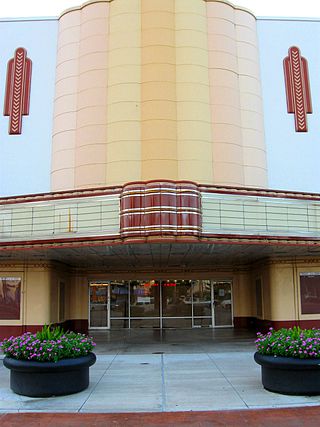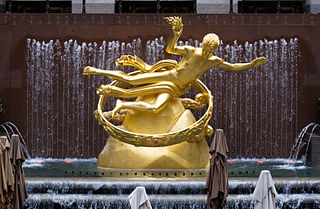
Streamline Moderne is an international style of Art Deco architecture and design that emerged in the 1930s. Inspired by aerodynamic design, it emphasized curving forms, long horizontal lines, and sometimes nautical elements. In industrial design, it was used in railroad locomotives, telephones, toasters, buses, appliances, and other devices to give the impression of sleekness and modernity.

The Pellissier Building and adjoining Wiltern Theatre is a 12-story, 155-foot (47 m) Art Deco landmark at the corner of Wilshire Boulevard and Western Avenue in Los Angeles, California. The entire complex is commonly referred to as the Wiltern Center. Clad in a blue-green glazed architectural terra-cotta tile and situated diagonal to the street corner, the complex is considered one of the finest examples of Art Deco architecture in the United States. The Wiltern building is owned privately, and the Wiltern Theatre is operated by Live Nation's Los Angeles division.

Stiles Oliver Clements was an architect practicing in Los Angeles and Southern California.

The Pantages Theatre is a historic theatre in Minneapolis, Minnesota. The original building was a Beaux-Arts style twelve-story complex on Hennepin Avenue, designed by Kees & Colburn and operated by Alexander Pantages, a Greek immigrant who opened 500 theatres.

The Uptown Theatre is one of the oldest surviving theaters in the Twin Cities area. It was in active use from 1916 to 2020. The theater reopened on June 10, 2023 as a music and event venue.

The Oak Street Cinema was a small, single-screen movie theater in the Stadium Village neighborhood of Minneapolis, Minnesota, near the University of Minnesota campus. The theater played both first-run independent films and repertory showings, including retrospectives of such filmmakers as Ingmar Bergman, Michelangelo Antonioni, Akira Kurosawa and others, as well as genre-based retrospectives. It had also been home to several local film festivals, including the Minneapolis-St. Paul International Film Festival. The theater has hosted visits from several well-known filmmakers and celebrities, such as Terry Gilliam, Michael Moore, Peter Fonda, Cyd Charisse, and many others.

The Alabama Theatre is a historic movie theater located at the intersection of Alabama Street and Shepherd Drive in the Upper Kirby district of Houston, Texas. Constructed in 1939, in the Art Deco and Streamline Moderne styles as a suburban theater, the Alabama primarily booked roadshow engagements through most of its history. Today, the theater is home to a Trader Joe's grocery store. It is one of the buildings of the Alabama Shepherd Shopping Center, owned by Weingarten Realty.

The Tower Theatre for the Performing Arts is a historic Streamline Moderne mixed-use theater in Fresno, California. Built in 1939, it opened to the public on December 15, 1939, under the management of Fox West Coast Theater Corporation. The building was designed by S. Charles Lee, with its tower inspired by the "Star Pylon" at the 1939 New York World's Fair. The theater underwent a renovation and reopened as a performing arts center in 1990, after being closed as a repertory cinema in 1989 due to financial troubles.

The Mississippi Lofts and Adler Theatre is an apartment building and theater complex located in downtown Davenport, Iowa, United States. It is individually listed on the National Register of Historic Places by its original name, the Hotel Mississippi and RKO Orpheum Theater. The Hotel Mississippi was listed on the Davenport Register of Historic Properties in 2005. In 2020 the complex was included as a contributing property in the Davenport Downtown Commercial Historic District.

Palmetto Theatre is a historic movie theater located at Hampton, Hampton County, South Carolina. It was built in 1946, and is an Art Deco-influenced Art Moderne style building. It features a prominent, ornate, projecting marquee with highly stylized neon lettering and geometric patterns. The theater was designed to seat 450 people, including balcony seats.

The Riverview Theater is a cinema in the Howe neighborhood of Minneapolis, Minnesota, United States. Designed by Liebenberg and Kaplan, the theater was built by theater owners Bill and Sidney Volk in 1948. After building a subsequent theater in a new ultramodern style, the Volks returned to the Riverview in 1956 and had its lobby area heavily renovated and updated. The Riverview remains one of several surviving single-screen cinemas in the Minneapolis–Saint Paul area and typically showed second-run films until the COVID-19 pandemic, when it switched to showing first-run movies. Since the early 2000s, it has been consistently recognized by City Pages as one of the best movie theaters in the area.

The Terrace Theatre was located at 3508 France Avenue North in Robbinsdale, Minnesota. Upon its opening on May 23, 1951, the Terrace received critical acclaim for its “bold architectural lines [and] extensive patron services.” The 1,299-seat theater, designed in the mid-century modern style by the Minneapolis architectural firm of Liebenberg & Kaplan (L&K) for movie exhibitors Sidney and William Volk, was a popular Twin Cities destination for nearly fifty years. It changed hands in 1980 and again in 1987, when it was remodeled from a single-screen auditorium into three screens by dividing the balcony. The last movie was screened in 1999 and the theater remained boarded up for seventeen years before it was demolished in the fall of 2016 to be replaced by a Hy-Vee grocery store.

The Art Deco style, which originated in France just before World War I, had an important impact on architecture and design in the United States in the 1920s and 1930s. The most notable examples are the skyscrapers of New York City, including the Empire State Building, Chrysler Building, and Rockefeller Center. It combined modern aesthetics, fine craftsmanship, and expensive materials, and became the symbol of luxury and modernity. While rarely used in residences, it was frequently used for office buildings, government buildings, train stations, movie theaters, diners and department stores. It also was frequently used in furniture, and in the design of automobiles, ocean liners, and everyday objects such as toasters and radio sets.
Liebenberg and Kaplan (L&K) was a Minneapolis architectural firm founded in 1923 by Jacob J. Liebenberg and Seeman I. Kaplan. Over a fifty-year period, L&K became one of the Twin Cities' most successful architectural firms, best known for designing/redesigning movie theaters. The firm also designed hospitals, places of worship, commercial and institutional buildings, country clubs, prestigious homes, radio and television stations, hotels, and apartment buildings. After designing Temple Israel and the Granada Theater in Minneapolis, the firm began specializing in acoustics and theater design and went on to plan the construction and/or renovation of more than 200 movie houses throughout Minnesota, North and South Dakota, Iowa, and Wisconsin. Architectural records, original drawings, and plans for some 2,500 Liebenberg and Kaplan projects are available for public use at the Northwest Architectural Archives.

The Ely State Theater is a historic movie theater in Ely, Minnesota, United States. It was designed by Liebenberg and Kaplan in Streamline Moderne style and built in 1936. The theater was listed on the National Register of Historic Places in 2015. It was nominated for epitomizing the small-town commissions of Liebenberg and Kaplan, the leading movie theater designers in the Upper Midwest during the Golden Age of Hollywood.
Perry E. Crosier (1890-1953) was an architect based in Minnesota, best known for the theatres he designed throughout Minnesota. He also designed apartment complexes and residences. Several of his works are listed on the National Register of Historic Places.

The Orpheum Theater, formerly the Sioux Falls Community Playhouse, is a historic theater at 315 North Phillips Avenue in downtown Sioux Falls, South Dakota. It is the oldest theater in Sioux Falls and was listed on the National Register of Historic Places in 1983. Originally, it hosted vaudeville performances, and briefly served as a movie theater before being converted again into a stage theater, which it remains today.

The Buchanan Theatre is a historic theater in Buchanan, Virginia. It was built in 1917 and underwent a 1949 renovation in the Moderne style. The brick building is two-storied, with apartments occupying the second floor. The theater closed in 1985 and sat empty until being purchased in 1999 and renovated over the next 18 months. It reopened as a movie house and community theater in 2002.





















